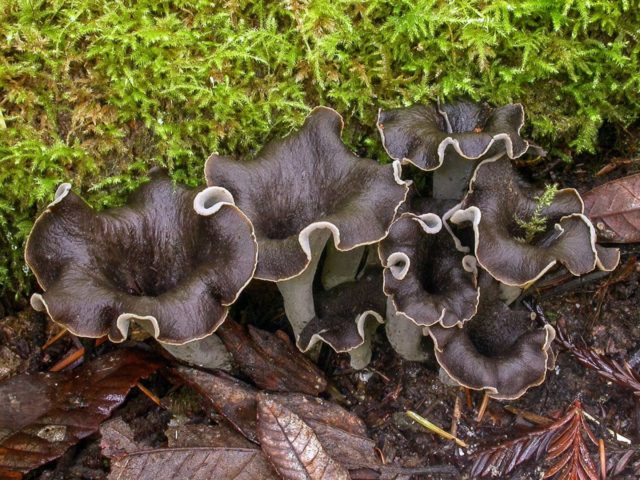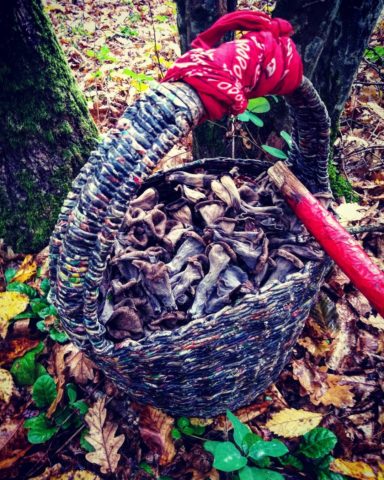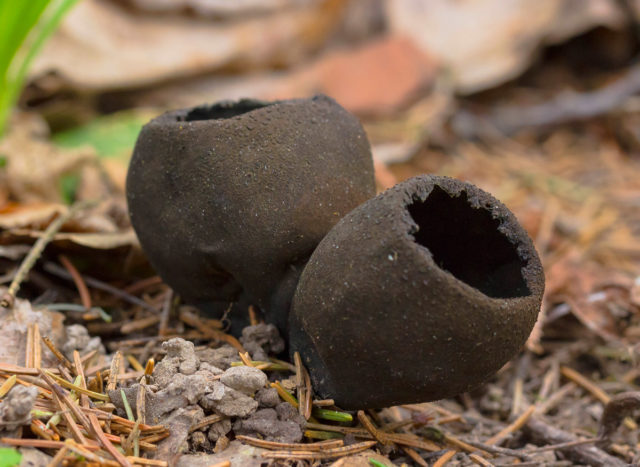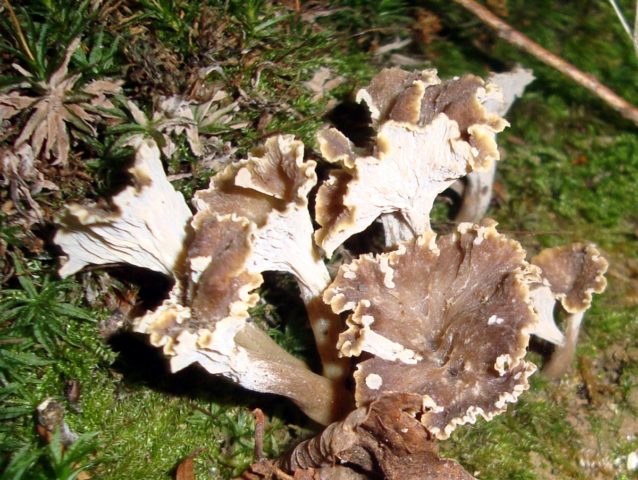Content
The horn-shaped funnel is one of the representatives of the Chanterelle family. Due to the unusual shape of the fruiting body, this species is also called the black horn or horn-shaped trumpet mushroom. In some publications you can find the erroneous name of the mushroom - gray chanterelle. It grows in groups and is distributed throughout the world. The official name of the species is Craterellus cornucopioides.
What does the horn-shaped funnel look like?
This mushroom is inconspicuous in the forest, so it is not so easy to see it in the grass. This is due to the fact that this species has a dark gray, almost black hue of the fruit body, which is lost against the background of yellowed fallen leaves. In addition, it is characterized by its small size and reaches a height of no more than 10 cm.
The cap of this mushroom is a funnel that expands from the bottom up and reaches a diameter of 3 to 8 cm. The surface of the funnel is folded, covered with scales and tubercles. In young specimens, the edges of the cap are wavy, bent outward. When ripe, they become lobed or torn. The spore powder is whitish.
The depression in the central part of the cap gradually passes into the leg, forming a cavity in it.
His flesh is fragile, with little physical impact, it easily breaks. In young specimens, it is gray-black, and by the time of maturation it becomes completely black. At the break, an unobtrusive mushroom smell is felt.
The leg of the horn-shaped funnel is short, its length reaches 0.5-1.2 cm, and its diameter is 1.5 cm. Its color is identical to that of the cap. Initially, the shade is brown-black, then it becomes dark gray, and in adult specimens it is almost black. As the mushroom dries, its color changes to a lighter one.
Spores are ovoid or elliptical in shape. They are smooth, colorless. Their size is 8-14 x 5-9 microns.
Where does the horn-shaped funnel grow
This species can be found in deciduous forests and mixed plantings. It is less common in mountainous areas. The horned funnel prefers to grow on limestone and clay soil at the base of beech and oak trees in fallen leaves.
It forms entire colonies on open forest edges, along roadsides and near the edge of ditches. It practically does not occur in overgrown grass. When located close, individual specimens grow together.
The main area of distribution is the temperate zone of the Northern Hemisphere. The mushroom can be found in Europe, North America, Asia and Japan. On the territory of Russia, it grows in the following regions:
- European part;
- Far East;
- Altai region;
- Caucasus;
- Western Siberia.
Is it possible to eat the horn-shaped funnel
This species belongs to the category of edible mushrooms. In England, France and Canada, it is considered a real delicacy. In terms of taste, it is compared with morels and truffles.
In raw form, the mushroom taste and smell are poorly expressed, but during heat treatment they become saturated. During the cooking process, the hue of the fruit body changes to black. The horn-shaped funnel has a neutral taste, so it can be seasoned with any seasonings, spices and sauces.
This type is easily absorbed by the body without causing a feeling of heaviness in the abdomen. During the cooking process, the water turns black, so it is recommended to drain it to obtain a clear broth.
False doubles
There are several types of mushrooms that are similar to the horn-shaped funnel. Therefore, it is worth studying their differences in order to avoid mistakes when collecting.
Existing counterparts:
- Dumped goblet (Urnula craterium). This species is characterized by a dense leathery structure of the fruit body in the form of a glass. The ripening period begins at the end of April and lasts until mid-May. It is considered an inedible mushroom.
- Chanterelle gray (Cantharellus cinereus). A distinctive feature is the folded hymenium on the back of the funnel. The pulp is rubbery-fibrous. The shade of the fruiting body is ashy. It belongs to the category of edible mushrooms, but does not have high taste.
Knowing the characteristic features of the twins, it will not be difficult to distinguish them from the horn-shaped funnel.
Collection rules and use
The ripening period for this mushroom is in late July and lasts until early October, weather conditions permitting. Mass plantings are most often found in August. In the southern regions, individual specimens can be collected in November.
Despite the fact that this species grows in crowded groups, it is not easy to find it in fallen leaves, since it is well camouflaged due to its color. But if you manage to find at least a few specimens, then you should take a closer look around, since there must be other representatives of the colony nearby. Having found the mushroom place of the horn-shaped funnel, you can collect a full basket within 10-15 minutes.
It is recommended to eat only the funnel-shaped cap, since the stem is stiff and fibrous. No special treatment is required before use. It is not necessary to remove the upper skin from the horn-shaped funnel, and there is also no special need to soak it first. Before cooking, the mushrooms need only be thoroughly cleaned of forest litter and rinsed well under running water.
The funnel-shaped funnel can be used for:
- canning;
- drying;
- freezing;
- cooking;
- getting seasoning.
This type can be prepared separately or included in other dishes.
Conclusion
The horn-shaped funnel is an edible species that many mushroom pickers undeservedly bypass. This is due to the unusual shape and dark shade of the fruit body. Taken together, this creates an erroneous opinion at the first acquaintance with him. Although considered a true delicacy in many countries, it is served in many prestigious restaurants.












